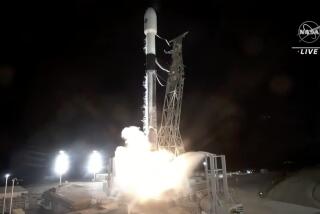Permit Denial Delayed : Chula Vista Gets More Time on Bayfront Plan
- Share via
Hours before federal officials intended to deny Chula Vista permission to take a first step toward developing its bayfront, Mayor Greg Cox on Wednesday persuaded the U.S. Army Corps of Engineers to give him three more weeks to prove the project is environmentally sound.
Larry Hawthorne, a Corps of Engineers spokesman, said Col. D. Fred Butler, the Corps’ regional commander, agreed Wednesday morning to withhold his decision on Chula Vista’s application for a permit to build a road through Sweetwater Marsh to Gunpowder Point.
Hawthorne said Butler opted to delay the decision after two telephone calls from Cox Tuesday night and Wednesday morning. Cox said he called Butler after learning that the Corps planned on Wednesday to withhold permission to build the road.
Sources close to the case said Tuesday that the denial was to have been based on the fact that the U.S. Fish and Wildlife Service had concluded that the road--and the hotel the city hopes to build on the point--would jeopardize the survival of three endangered species.
“We certainly wanted to have the opportunity to respond to and refute with verifiable biological information some of the comments” of the wildlife service, Cox said Wednesday. Butler gave Cox until April 4 to submit information that might rebut the service’s position.
Meanwhile, Larry Silver, a lawyer with the Sierra Club Legal Defense Fund in San Francisco, said the environmental group very likely would sue the Corps of Engineers if it decided to grant the permit over the objections of the Fish and Wildlife Service.
The Sierra Club is already suing the California Coastal Commission over its 1984 approval of the bayfront plan.
According to Cox, the city will use the delay to provide the Corps of Engineers with information from an environmental study of the 500-acre bayfront plan prepared for the city in the early 1980s. He said the study, conducted by a biological consulting firm in Sacramento, concluded that if properly done, the project could be environmentally sensitive.
Cox said the city used the study to convince the California Coastal Commission to approve the plan in 1984. He suggested the wildlife service ignored the consultants’ findings in preparing its opinion in opposition to the road.
But Nancy Kaufman, supervisor for the service in Southern California, said her office took the consultants’ findings into account. She said the city would have to provide “new scientific information that was heretofore unavailable” to refute the service’s conclusions.
At issue are the direct and indirect effects of the 1,200-foot road through the marsh on the light-footed clapper rail, the California least tern and the salt marsh bird’s beak, a plant on the federal endangered species list.
Cox argued Wednesday that the least tern population and the plants are up to three-eighths of a mile away from the proposed road and would not be affected by it. As for clapper rails, he said the city has offered to build passageways to enable them to walk under the road.
Kaufman countered that the indirect effects of the road and related development--such as contaminated road runoff from heavy traffic and fertilizers and pesticides from landscaping the hotel--would spread beyond the the area immediately adjacent to the road.
She said passageways under the 20-foot-wide road would not help the clapper rails because they would only walk through if there were enough light to encourage certain types of vegetation. She said the width of the proposed road would not permit that light.
“They won’t scurry through a dark hole,” she said. “They aren’t those kinds of creatures. Animals rarely cooperate.”
More to Read
Sign up for Essential California
The most important California stories and recommendations in your inbox every morning.
You may occasionally receive promotional content from the Los Angeles Times.










